An 18 Crash Course Lesson in Mexican Food: La Casita Mexicana

I would say it was serendipity that day at the Gold Standard.
Those two chef?s I always saw on that Univision morning show ?Despierta America? my mom watched everyday were there, and I, forced myself to introduce myself to them: Ramiro ArvizU and Jaime Martin Del Campo of La Casita Mexicana. It was long overdue. They were sampling some Ceviche Verde(Green) that I initially thought to be just a chef-ed up version of the classic Tomato-Onion-Lime Mexican Seafood classic. Tasting it, the unique, bitter taste of Epazote, known as the "Skunk Plant" back in Aztec time stood out immediately. The type of fish used that day was the signature wide-flaked flesh of Bacalao(Cod), a saltwater fish that is also readily available in the Southeast Coastal regions. Hmmm?
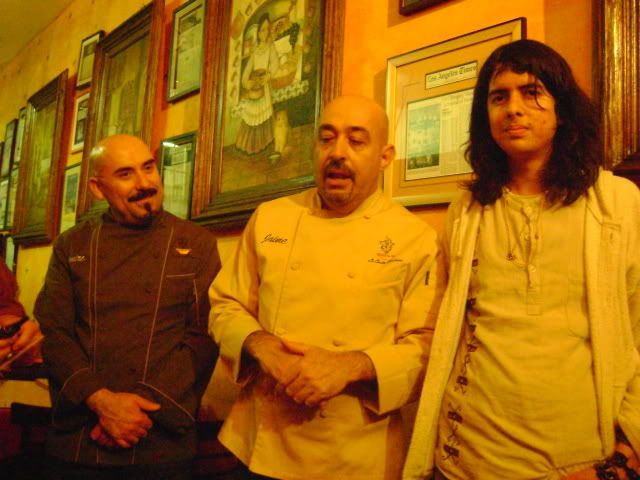 Going up to them, they immediately informed me it was a version seen among some provinces around Veracruzwhere Epazoteis still used as well as Cilantro. This sparked a rather long, detailed conversation that only two passionate chefs and a self-discovering food writer could keep up with. Not just about food, but?authenticfood from Mexico. The other dishes that never made it to the Mexican Chain Menu quo of Fajita platters, ?hard shell? Taco?s & ?Wet? Burritos a? plenty.
Going up to them, they immediately informed me it was a version seen among some provinces around Veracruzwhere Epazoteis still used as well as Cilantro. This sparked a rather long, detailed conversation that only two passionate chefs and a self-discovering food writer could keep up with. Not just about food, but?authenticfood from Mexico. The other dishes that never made it to the Mexican Chain Menu quo of Fajita platters, ?hard shell? Taco?s & ?Wet? Burritos a? plenty.
My roots, my past, my history, a sacred bond I?ve recently discovered in my first trip to my parents state of Zacatecas, Mexico?was not this. This unfortunate truth was equally?if not even more?mourned by them. That was it. Something needed to be done to clear the greasy, cheap, easily prepared confusion that is sadly the bar for most Mexican food in the U.S, yes...even L.A. So, I rallied the diligent few who spun their own web, straying from the allotted venting of Yelpand Chowhound: the Los Angeles Food Bloggers (only ones that make it to my links on lower right), they have become a foodie family for me and I felt they needed to know what really was up.
An 18 course learning experience was to be had on Wednesday March 25, 2009 at La Casita Mexicana. This was that dinner.
We started off with a showcasing of many traditional Mexican foodstuffs.
Black Corn is grown in only select regions in Mexico because it is a lot harder to maintain. Their kernels are almost as starchy as potato when cooked.
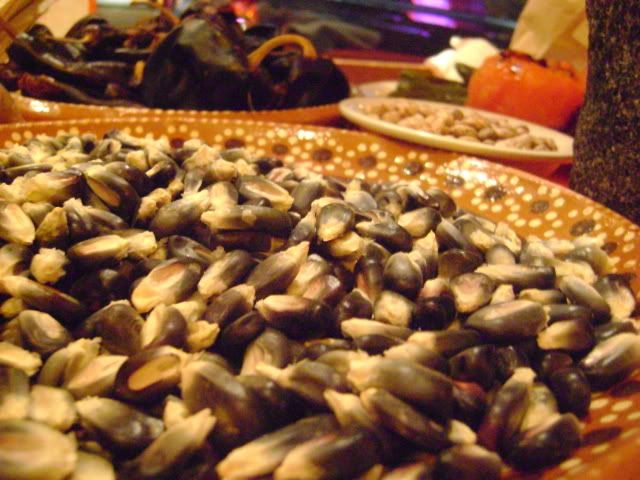 Preserving foods is an Art in Mexico that is practiced with just about any perishable, in an attempt to let less go to waste. Even making jams with savory items like Cactus paddles and Chayotea water-fleshed gourd vegetable apparent in more Central states.
Preserving foods is an Art in Mexico that is practiced with just about any perishable, in an attempt to let less go to waste. Even making jams with savory items like Cactus paddles and Chayotea water-fleshed gourd vegetable apparent in more Central states.
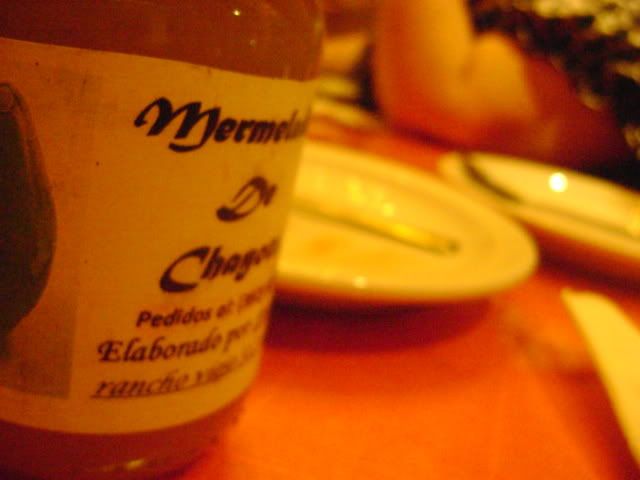 Of course, a table side showing of old fashioned Salsa making was thrown in there somewhere...Lava Rock Molcajeteand good 'ol Elbow grease, no blender/food processor, keeping it old school.
Of course, a table side showing of old fashioned Salsa making was thrown in there somewhere...Lava Rock Molcajeteand good 'ol Elbow grease, no blender/food processor, keeping it old school.
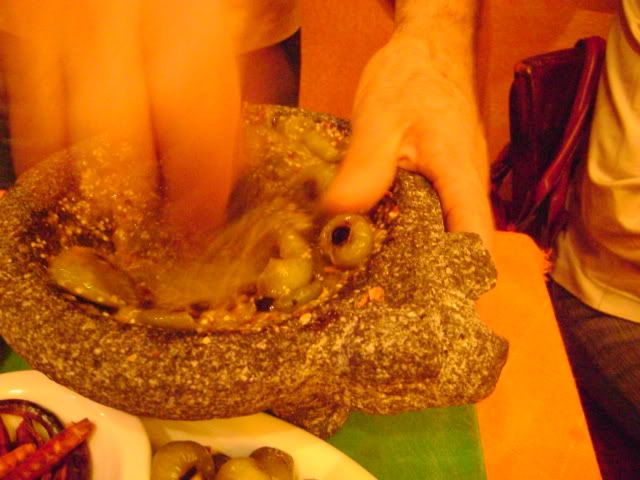 They busted out with 3 different kinds.
They busted out with 3 different kinds.
Salsa de Jitomate con Chile Serrano y Cilantro MEXICANO(Tomato, chile, Mexican Cilantro; taste different than Domestic Cilantro, less strong)
Salsa de Tomatillo de Milpa Con Semillas de Calabaza y Chiles de Arbol Tostados(Wild Foraged Tomatillos, Pumpkin Seeds and Toasted Tree Chile)
Salsa Cruda de Tomatillo y Hoja Santa(Raw Tomatillo with Hoja Santa; tart, acidic and spicy)
Now, it's time for the main lesson: 18 courses, covering the barren desert bounty, the humid coastal concoctions to the ways of the tropical wetland--Mexican gastronomy at it's tribal finest.
1st Course:
Sopa de Pescado con Hoja Santa y Chile Jalapeños(Fish Soup with Hoja Santa Leaf and Chile Jalapeños)
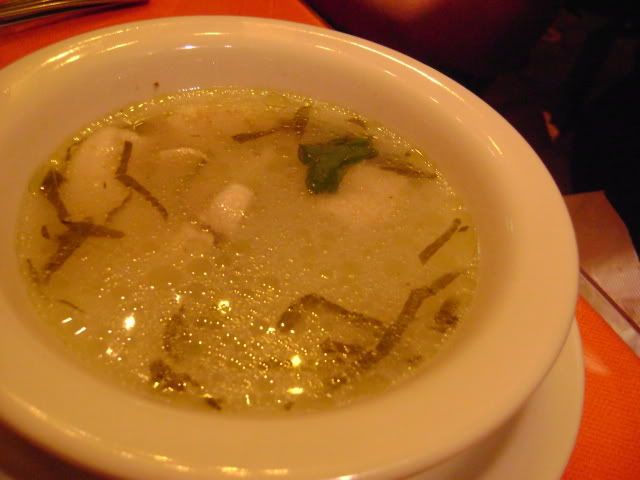 Hoja Santa is a broad leaf used as an Herb mostly Oaxacan dishes, the flavor and smell is reminiscent of root beer. Some diners were suprised how the soup had some Tom Yumqualities to it, this is how it is when prepared good, that's all.
Hoja Santa is a broad leaf used as an Herb mostly Oaxacan dishes, the flavor and smell is reminiscent of root beer. Some diners were suprised how the soup had some Tom Yumqualities to it, this is how it is when prepared good, that's all.
2nd Course: Chile Jalapeños Rellenos de Atun(Tuna Stuffed Jalapeños)
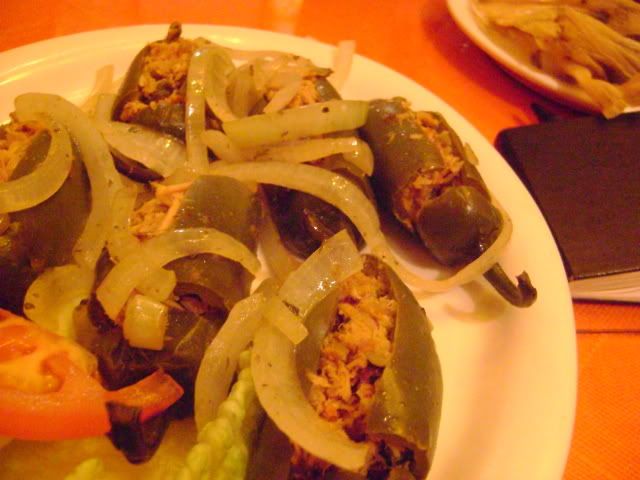 Tuna has made it's way into Mexican Culture. Seen more in coastal states like Veracruz. These are not as spicy as you would think.
Tuna has made it's way into Mexican Culture. Seen more in coastal states like Veracruz. These are not as spicy as you would think.
3rd Course: Queso Azteca(4 different Cow cheeses, blended with Epazote, Chiles Poblanos and little strips of Cactus, Nopalitos. This is then wrapped with a Banana Leaf and Grilled on open flame)
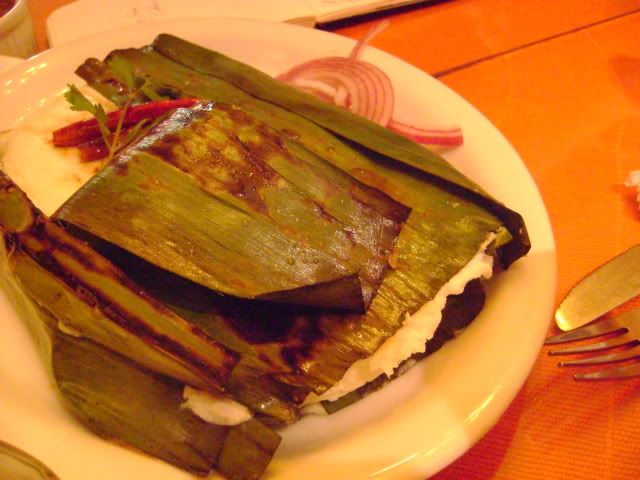 Kind of like a deconstructed, really good Quesadilla4th Course: Tamalitos de Huitlacoche(Corn Fungus Tamales)
Kind of like a deconstructed, really good Quesadilla4th Course: Tamalitos de Huitlacoche(Corn Fungus Tamales)
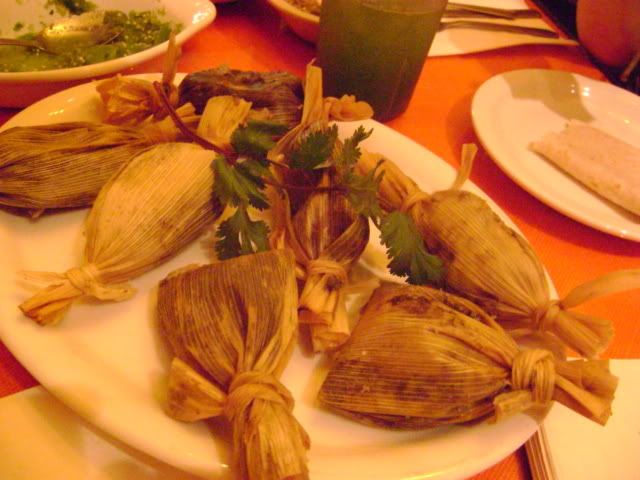 Seasonal, mostly seen during May. The jet-black fungus that grows on few, lucky Ears of Corn are prized in Mexico. Usually pricey and used in Quesadillas in Central Metropolitan street food.
Seasonal, mostly seen during May. The jet-black fungus that grows on few, lucky Ears of Corn are prized in Mexico. Usually pricey and used in Quesadillas in Central Metropolitan street food.
5th Course: Enchiladas de Pollo con Tres Moles (Poblano, Pepian Verde y Rojo)
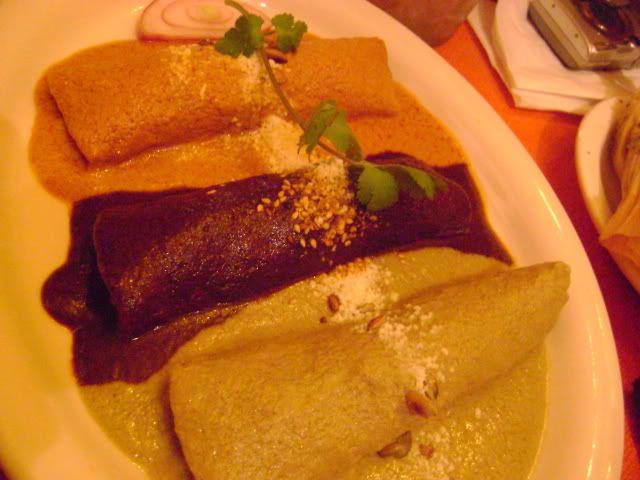 Not just beautiful looking. Each sauce bringing it's own essence from different regions of Mexico. Sweet Poblano from Puebla, nutty Pumpkin Seed-intensive Pepian Verde from Central States, and Spicy Rojo from Southern Central.
Not just beautiful looking. Each sauce bringing it's own essence from different regions of Mexico. Sweet Poblano from Puebla, nutty Pumpkin Seed-intensive Pepian Verde from Central States, and Spicy Rojo from Southern Central.
6th Course: Enchiladas Rojas de Queso Cotija from Michoacan(Enchiladas with Mexican Dry Cheese in style of Michoacan)
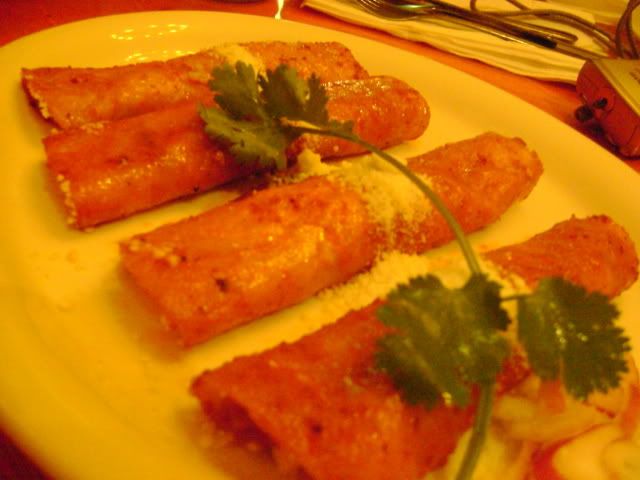 Keeping the age-old tradition of lightly dipping the tortillas in hot oil before Chile makes layers of flavor.
Keeping the age-old tradition of lightly dipping the tortillas in hot oil before Chile makes layers of flavor.
7th Course: Mole de Almendras con Carne de Puerco(Almond Mole with Pork)
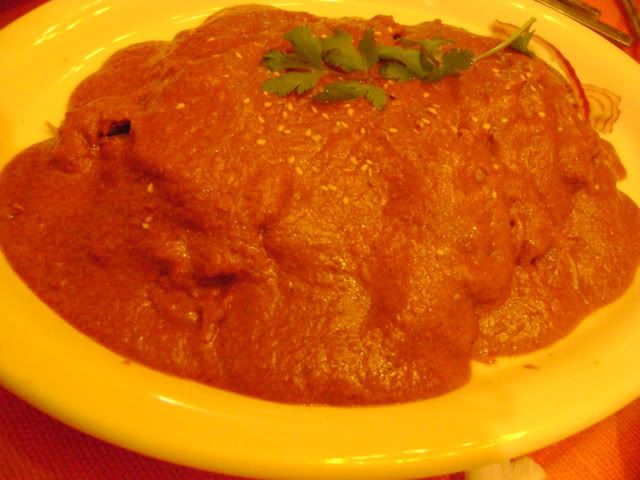 This protein is choice all around the Motherland but in combination with Molenot so much, popular in Jalisco.
This protein is choice all around the Motherland but in combination with Molenot so much, popular in Jalisco.
8th Course: Mole Blanco(White Mole)
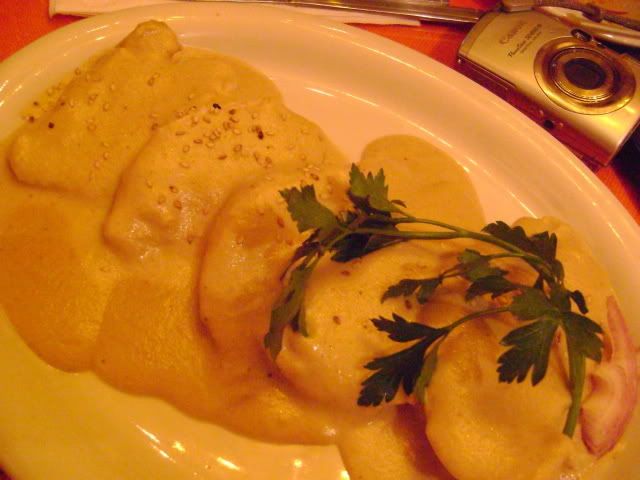 This Mole is an antique recipe found in Tlaxcalawith touches by Jaime y Ramiro. It is believed to have it's origins by abiding to a Brides demand of not wanting to get dirty on her Wedding day. Made with same ingredients but just their white counterparts: White Chocolate, White Raisins, White Chiles etc..
This Mole is an antique recipe found in Tlaxcalawith touches by Jaime y Ramiro. It is believed to have it's origins by abiding to a Brides demand of not wanting to get dirty on her Wedding day. Made with same ingredients but just their white counterparts: White Chocolate, White Raisins, White Chiles etc..
9th Course: Puerco Adobado (Pork in Spice-Intensive Red Sauce)
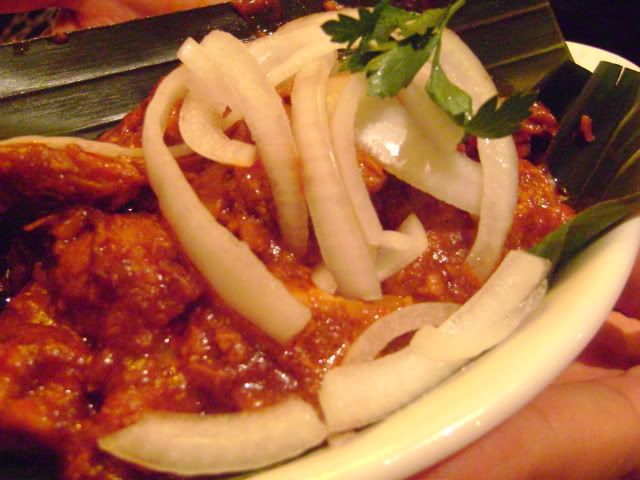 Sweet and Spicy Sauce...Mexican Style. Jaime and Ramiro said this was from a recipe some Aunt had or something.
Sweet and Spicy Sauce...Mexican Style. Jaime and Ramiro said this was from a recipe some Aunt had or something.
10th Course: Cochinita Pibil from El Yucatan(Pork Roasted in Plantain Leaf with Achiote Spice, spicy Habanero Pepper and Bitter Orange fruit)
I know it was floating around somewhere in the Table, didn't get a chance to take a photo.
Naranja Agria are excruciatingly hard to find in L.A, needing almost entirely sub-tropical climate, it is used in many Latin American cuisines. It has a special kind of puckering tartness to it found in no other citrus fruit. I think they found someone who grows it in their backyard recently...
11th Course: Pescado en Salsa de Tamarindo con Chile de Arbol(Fish with Tamarind-Chile Sauce)
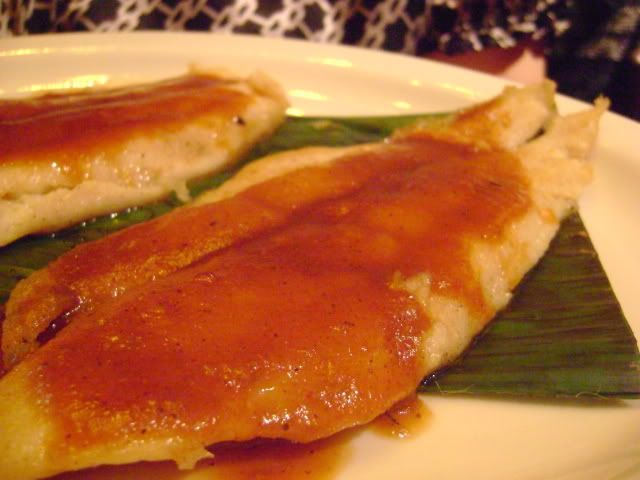 Tamarindo pods are peeled and made into candy, drinks, topping for Raspados(Mexican Shaved Ice). Here, they dug for this recipe incorporating pods freshly imported from Nayarit. The sauce was tart and spicy, excellent for fish.
Tamarindo pods are peeled and made into candy, drinks, topping for Raspados(Mexican Shaved Ice). Here, they dug for this recipe incorporating pods freshly imported from Nayarit. The sauce was tart and spicy, excellent for fish.
12th Course: Cecina al chipotle(Dry-Cured Beef cooked and slathered with smoked Chipotle Chile)
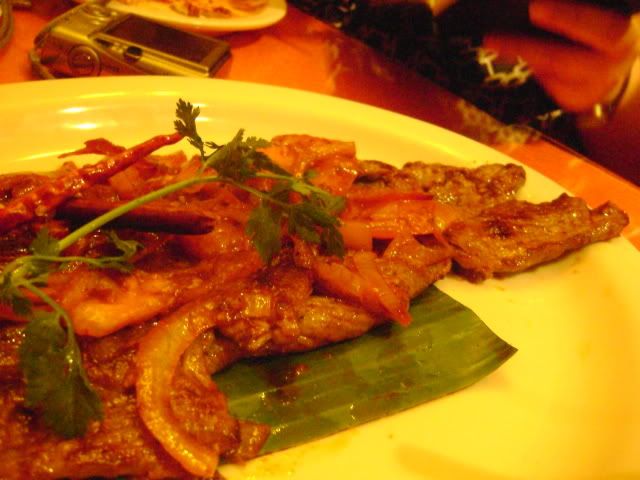 Beef dish hailing from Veracruzregion to dyspel belief that all of their food is Seafood, it's one of the few dishes where Chipotle Peppers as well as Olive Oil is used in cooking, Olive oil goes for entire region's cooking.
Beef dish hailing from Veracruzregion to dyspel belief that all of their food is Seafood, it's one of the few dishes where Chipotle Peppers as well as Olive Oil is used in cooking, Olive oil goes for entire region's cooking.
13th Course: Chiles en Nogada (No Translation)
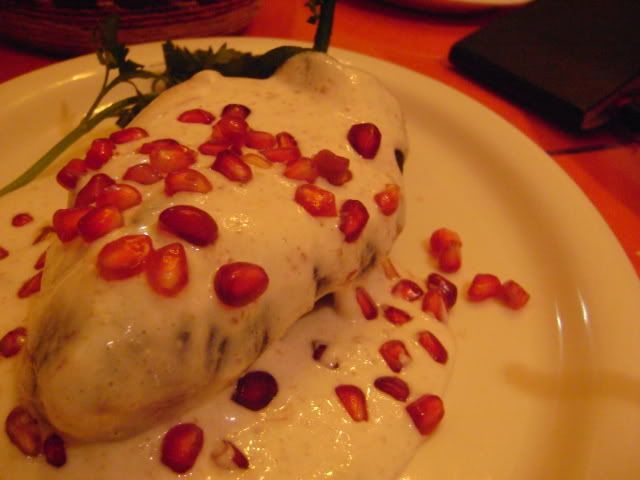 This is probably Jaime and Ramiro's most notorious dish. Cooking the pepper to crunchy perfection, stuffing it with ground pork mixture involving Dulce de Biznaga(Crystallized Cactus), topping it all with a Pueblancream sauce made from Pecans, and finally sprinkling a few fresh Pomegranate seeds on top.
This is probably Jaime and Ramiro's most notorious dish. Cooking the pepper to crunchy perfection, stuffing it with ground pork mixture involving Dulce de Biznaga(Crystallized Cactus), topping it all with a Pueblancream sauce made from Pecans, and finally sprinkling a few fresh Pomegranate seeds on top.
Dulce de Biznagais becoming harder and harder to find, making it a lot more expensive where ever they do have it. It tastes faintfully herbal, also used in Mexican desserts.
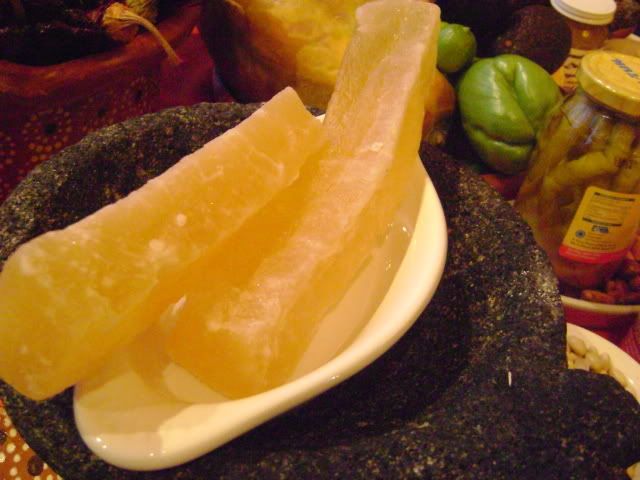 14th Course: Churros Rellenos de Cajeta (Caramel-Stuffed Churros)
14th Course: Churros Rellenos de Cajeta (Caramel-Stuffed Churros)
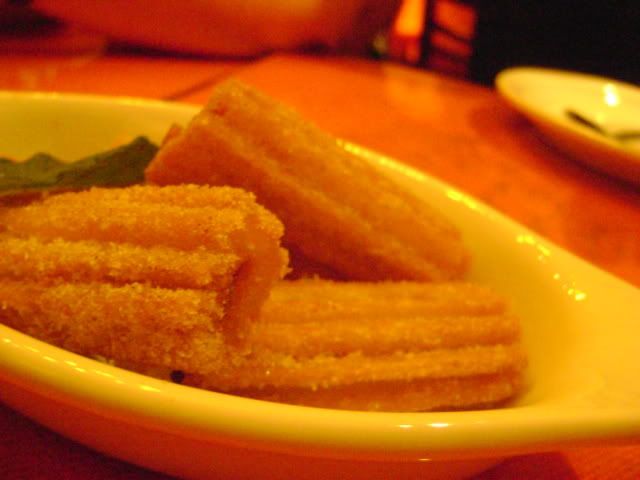 Caramel is universally loved all through out Mexico, both it's Goat's and Cow's Milk ones (probably equal). Rich and when done good, not cloying. Churros are superb with this.
Caramel is universally loved all through out Mexico, both it's Goat's and Cow's Milk ones (probably equal). Rich and when done good, not cloying. Churros are superb with this.
15th Course: Flan de Calabaza de Castilla (Domesticated Pumpkin Flan)
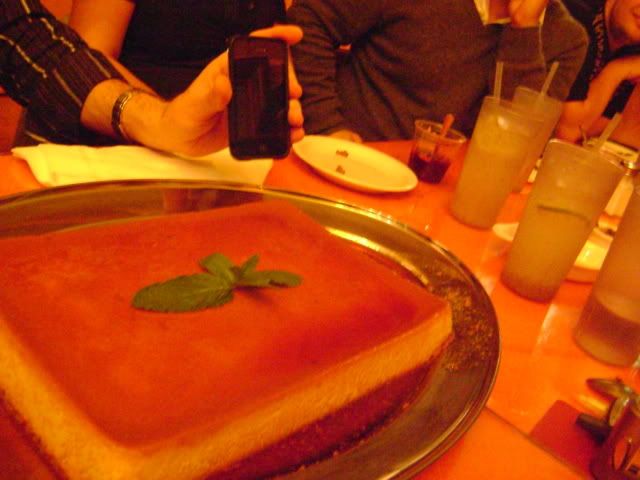 Jaime and Ramiro made a huge sheet of Flan for the whole table! Pumpkin sweets are hugely popular all through out Mexico. In this Flan, it just added another realm of silkiness.
Jaime and Ramiro made a huge sheet of Flan for the whole table! Pumpkin sweets are hugely popular all through out Mexico. In this Flan, it just added another realm of silkiness.
16th Course: Ponche de Jamaica con Jocotes y Nuez(Hibiscus Punch with Pecan Pieces and Jocote Fruit)
 Traditionally mixed with Tequila, this is a Winter, Christmas time only drink. It's just a motley brew of about whatever fruit you can find. This time it was Jocotes, tiny crabapple-like fruit.
Traditionally mixed with Tequila, this is a Winter, Christmas time only drink. It's just a motley brew of about whatever fruit you can find. This time it was Jocotes, tiny crabapple-like fruit.
17th Course: Flan de Calabasita (Zucchini Flan)
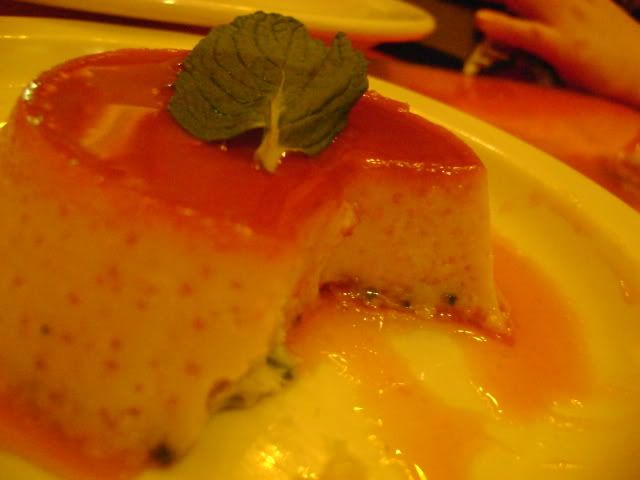 Zucchini--when it is abundant--is also used in sweets. Here, it's strips added nice textural contrast to silky Flan.
Zucchini--when it is abundant--is also used in sweets. Here, it's strips added nice textural contrast to silky Flan.
18th Course: Toronja Grajeada con pasta de Chocolate Mexicano (Crystallized Grapefruit Wedges with Mexican Chocolate Paste)
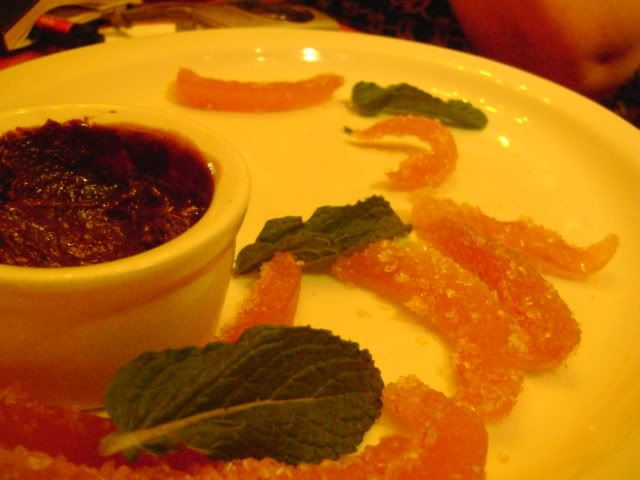 Super Labor Intensive, process taking 24 hours to complete. Apparently, in older times, this dish was made by nuns for the highest class of clergymen, cardinals etc. Grapefruit is dessicated with Rock Sugar and then dipped in chunky chocolate paste.
Super Labor Intensive, process taking 24 hours to complete. Apparently, in older times, this dish was made by nuns for the highest class of clergymen, cardinals etc. Grapefruit is dessicated with Rock Sugar and then dipped in chunky chocolate paste.
This was it. I hope we all learned something.
I certainly did...a lot of new things I myself didn't even know.
La Casita Mexicana
4030 Gage Ave Bell,
CA 90201
(323) 773-1898
Open Daily 9am-10pm
Those two chef?s I always saw on that Univision morning show ?Despierta America? my mom watched everyday were there, and I, forced myself to introduce myself to them: Ramiro ArvizU and Jaime Martin Del Campo of La Casita Mexicana. It was long overdue. They were sampling some Ceviche Verde(Green) that I initially thought to be just a chef-ed up version of the classic Tomato-Onion-Lime Mexican Seafood classic. Tasting it, the unique, bitter taste of Epazote, known as the "Skunk Plant" back in Aztec time stood out immediately. The type of fish used that day was the signature wide-flaked flesh of Bacalao(Cod), a saltwater fish that is also readily available in the Southeast Coastal regions. Hmmm?
 Going up to them, they immediately informed me it was a version seen among some provinces around Veracruzwhere Epazoteis still used as well as Cilantro. This sparked a rather long, detailed conversation that only two passionate chefs and a self-discovering food writer could keep up with. Not just about food, but?authenticfood from Mexico. The other dishes that never made it to the Mexican Chain Menu quo of Fajita platters, ?hard shell? Taco?s & ?Wet? Burritos a? plenty.
Going up to them, they immediately informed me it was a version seen among some provinces around Veracruzwhere Epazoteis still used as well as Cilantro. This sparked a rather long, detailed conversation that only two passionate chefs and a self-discovering food writer could keep up with. Not just about food, but?authenticfood from Mexico. The other dishes that never made it to the Mexican Chain Menu quo of Fajita platters, ?hard shell? Taco?s & ?Wet? Burritos a? plenty. My roots, my past, my history, a sacred bond I?ve recently discovered in my first trip to my parents state of Zacatecas, Mexico?was not this. This unfortunate truth was equally?if not even more?mourned by them. That was it. Something needed to be done to clear the greasy, cheap, easily prepared confusion that is sadly the bar for most Mexican food in the U.S, yes...even L.A. So, I rallied the diligent few who spun their own web, straying from the allotted venting of Yelpand Chowhound: the Los Angeles Food Bloggers (only ones that make it to my links on lower right), they have become a foodie family for me and I felt they needed to know what really was up.
An 18 course learning experience was to be had on Wednesday March 25, 2009 at La Casita Mexicana. This was that dinner.
We started off with a showcasing of many traditional Mexican foodstuffs.
Black Corn is grown in only select regions in Mexico because it is a lot harder to maintain. Their kernels are almost as starchy as potato when cooked.
 Preserving foods is an Art in Mexico that is practiced with just about any perishable, in an attempt to let less go to waste. Even making jams with savory items like Cactus paddles and Chayotea water-fleshed gourd vegetable apparent in more Central states.
Preserving foods is an Art in Mexico that is practiced with just about any perishable, in an attempt to let less go to waste. Even making jams with savory items like Cactus paddles and Chayotea water-fleshed gourd vegetable apparent in more Central states.  Of course, a table side showing of old fashioned Salsa making was thrown in there somewhere...Lava Rock Molcajeteand good 'ol Elbow grease, no blender/food processor, keeping it old school.
Of course, a table side showing of old fashioned Salsa making was thrown in there somewhere...Lava Rock Molcajeteand good 'ol Elbow grease, no blender/food processor, keeping it old school.  They busted out with 3 different kinds.
They busted out with 3 different kinds. Salsa de Jitomate con Chile Serrano y Cilantro MEXICANO(Tomato, chile, Mexican Cilantro; taste different than Domestic Cilantro, less strong)
Salsa de Tomatillo de Milpa Con Semillas de Calabaza y Chiles de Arbol Tostados(Wild Foraged Tomatillos, Pumpkin Seeds and Toasted Tree Chile)
Salsa Cruda de Tomatillo y Hoja Santa(Raw Tomatillo with Hoja Santa; tart, acidic and spicy)
Now, it's time for the main lesson: 18 courses, covering the barren desert bounty, the humid coastal concoctions to the ways of the tropical wetland--Mexican gastronomy at it's tribal finest.
1st Course:
Sopa de Pescado con Hoja Santa y Chile Jalapeños(Fish Soup with Hoja Santa Leaf and Chile Jalapeños)
 Hoja Santa is a broad leaf used as an Herb mostly Oaxacan dishes, the flavor and smell is reminiscent of root beer. Some diners were suprised how the soup had some Tom Yumqualities to it, this is how it is when prepared good, that's all.
Hoja Santa is a broad leaf used as an Herb mostly Oaxacan dishes, the flavor and smell is reminiscent of root beer. Some diners were suprised how the soup had some Tom Yumqualities to it, this is how it is when prepared good, that's all. 2nd Course: Chile Jalapeños Rellenos de Atun(Tuna Stuffed Jalapeños)
 Tuna has made it's way into Mexican Culture. Seen more in coastal states like Veracruz. These are not as spicy as you would think.
Tuna has made it's way into Mexican Culture. Seen more in coastal states like Veracruz. These are not as spicy as you would think. 3rd Course: Queso Azteca(4 different Cow cheeses, blended with Epazote, Chiles Poblanos and little strips of Cactus, Nopalitos. This is then wrapped with a Banana Leaf and Grilled on open flame)
 Kind of like a deconstructed, really good Quesadilla4th Course: Tamalitos de Huitlacoche(Corn Fungus Tamales)
Kind of like a deconstructed, really good Quesadilla4th Course: Tamalitos de Huitlacoche(Corn Fungus Tamales)  Seasonal, mostly seen during May. The jet-black fungus that grows on few, lucky Ears of Corn are prized in Mexico. Usually pricey and used in Quesadillas in Central Metropolitan street food.
Seasonal, mostly seen during May. The jet-black fungus that grows on few, lucky Ears of Corn are prized in Mexico. Usually pricey and used in Quesadillas in Central Metropolitan street food. 5th Course: Enchiladas de Pollo con Tres Moles (Poblano, Pepian Verde y Rojo)
 Not just beautiful looking. Each sauce bringing it's own essence from different regions of Mexico. Sweet Poblano from Puebla, nutty Pumpkin Seed-intensive Pepian Verde from Central States, and Spicy Rojo from Southern Central.
Not just beautiful looking. Each sauce bringing it's own essence from different regions of Mexico. Sweet Poblano from Puebla, nutty Pumpkin Seed-intensive Pepian Verde from Central States, and Spicy Rojo from Southern Central. 6th Course: Enchiladas Rojas de Queso Cotija from Michoacan(Enchiladas with Mexican Dry Cheese in style of Michoacan)
 Keeping the age-old tradition of lightly dipping the tortillas in hot oil before Chile makes layers of flavor.
Keeping the age-old tradition of lightly dipping the tortillas in hot oil before Chile makes layers of flavor. 7th Course: Mole de Almendras con Carne de Puerco(Almond Mole with Pork)
 This protein is choice all around the Motherland but in combination with Molenot so much, popular in Jalisco.
This protein is choice all around the Motherland but in combination with Molenot so much, popular in Jalisco. 8th Course: Mole Blanco(White Mole)
 This Mole is an antique recipe found in Tlaxcalawith touches by Jaime y Ramiro. It is believed to have it's origins by abiding to a Brides demand of not wanting to get dirty on her Wedding day. Made with same ingredients but just their white counterparts: White Chocolate, White Raisins, White Chiles etc..
This Mole is an antique recipe found in Tlaxcalawith touches by Jaime y Ramiro. It is believed to have it's origins by abiding to a Brides demand of not wanting to get dirty on her Wedding day. Made with same ingredients but just their white counterparts: White Chocolate, White Raisins, White Chiles etc.. 9th Course: Puerco Adobado (Pork in Spice-Intensive Red Sauce)
 Sweet and Spicy Sauce...Mexican Style. Jaime and Ramiro said this was from a recipe some Aunt had or something.
Sweet and Spicy Sauce...Mexican Style. Jaime and Ramiro said this was from a recipe some Aunt had or something. 10th Course: Cochinita Pibil from El Yucatan(Pork Roasted in Plantain Leaf with Achiote Spice, spicy Habanero Pepper and Bitter Orange fruit)
I know it was floating around somewhere in the Table, didn't get a chance to take a photo.
Naranja Agria are excruciatingly hard to find in L.A, needing almost entirely sub-tropical climate, it is used in many Latin American cuisines. It has a special kind of puckering tartness to it found in no other citrus fruit. I think they found someone who grows it in their backyard recently...
11th Course: Pescado en Salsa de Tamarindo con Chile de Arbol(Fish with Tamarind-Chile Sauce)
 Tamarindo pods are peeled and made into candy, drinks, topping for Raspados(Mexican Shaved Ice). Here, they dug for this recipe incorporating pods freshly imported from Nayarit. The sauce was tart and spicy, excellent for fish.
Tamarindo pods are peeled and made into candy, drinks, topping for Raspados(Mexican Shaved Ice). Here, they dug for this recipe incorporating pods freshly imported from Nayarit. The sauce was tart and spicy, excellent for fish. 12th Course: Cecina al chipotle(Dry-Cured Beef cooked and slathered with smoked Chipotle Chile)
 Beef dish hailing from Veracruzregion to dyspel belief that all of their food is Seafood, it's one of the few dishes where Chipotle Peppers as well as Olive Oil is used in cooking, Olive oil goes for entire region's cooking.
Beef dish hailing from Veracruzregion to dyspel belief that all of their food is Seafood, it's one of the few dishes where Chipotle Peppers as well as Olive Oil is used in cooking, Olive oil goes for entire region's cooking. 13th Course: Chiles en Nogada (No Translation)
 This is probably Jaime and Ramiro's most notorious dish. Cooking the pepper to crunchy perfection, stuffing it with ground pork mixture involving Dulce de Biznaga(Crystallized Cactus), topping it all with a Pueblancream sauce made from Pecans, and finally sprinkling a few fresh Pomegranate seeds on top.
This is probably Jaime and Ramiro's most notorious dish. Cooking the pepper to crunchy perfection, stuffing it with ground pork mixture involving Dulce de Biznaga(Crystallized Cactus), topping it all with a Pueblancream sauce made from Pecans, and finally sprinkling a few fresh Pomegranate seeds on top. Dulce de Biznagais becoming harder and harder to find, making it a lot more expensive where ever they do have it. It tastes faintfully herbal, also used in Mexican desserts.
 14th Course: Churros Rellenos de Cajeta (Caramel-Stuffed Churros)
14th Course: Churros Rellenos de Cajeta (Caramel-Stuffed Churros)  Caramel is universally loved all through out Mexico, both it's Goat's and Cow's Milk ones (probably equal). Rich and when done good, not cloying. Churros are superb with this.
Caramel is universally loved all through out Mexico, both it's Goat's and Cow's Milk ones (probably equal). Rich and when done good, not cloying. Churros are superb with this. 15th Course: Flan de Calabaza de Castilla (Domesticated Pumpkin Flan)
 Jaime and Ramiro made a huge sheet of Flan for the whole table! Pumpkin sweets are hugely popular all through out Mexico. In this Flan, it just added another realm of silkiness.
Jaime and Ramiro made a huge sheet of Flan for the whole table! Pumpkin sweets are hugely popular all through out Mexico. In this Flan, it just added another realm of silkiness. 16th Course: Ponche de Jamaica con Jocotes y Nuez(Hibiscus Punch with Pecan Pieces and Jocote Fruit)
 Traditionally mixed with Tequila, this is a Winter, Christmas time only drink. It's just a motley brew of about whatever fruit you can find. This time it was Jocotes, tiny crabapple-like fruit.
Traditionally mixed with Tequila, this is a Winter, Christmas time only drink. It's just a motley brew of about whatever fruit you can find. This time it was Jocotes, tiny crabapple-like fruit. 17th Course: Flan de Calabasita (Zucchini Flan)
 Zucchini--when it is abundant--is also used in sweets. Here, it's strips added nice textural contrast to silky Flan.
Zucchini--when it is abundant--is also used in sweets. Here, it's strips added nice textural contrast to silky Flan. 18th Course: Toronja Grajeada con pasta de Chocolate Mexicano (Crystallized Grapefruit Wedges with Mexican Chocolate Paste)
 Super Labor Intensive, process taking 24 hours to complete. Apparently, in older times, this dish was made by nuns for the highest class of clergymen, cardinals etc. Grapefruit is dessicated with Rock Sugar and then dipped in chunky chocolate paste.
Super Labor Intensive, process taking 24 hours to complete. Apparently, in older times, this dish was made by nuns for the highest class of clergymen, cardinals etc. Grapefruit is dessicated with Rock Sugar and then dipped in chunky chocolate paste. This was it. I hope we all learned something.
I certainly did...a lot of new things I myself didn't even know.
La Casita Mexicana
4030 Gage Ave Bell,
CA 90201
(323) 773-1898
Open Daily 9am-10pm
Teenage Glutster
Comments
anonymous
WHAT RECIPES? THERE ARE NO RECIPES FOR LA CASITA MEXICANA?